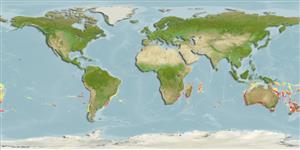Common names from other countries
>
Scombriformes (Mackerels) >
Trichiuridae (Cutlassfishes) > Aphanopodinae
Etymology: Benthodesmus: Greek, benthos = depth of the sea + Greek, desmos = bond, chain (Ref. 45335).
Environment: milieu / climate zone / depth range / distribution range
Ecologia
marinhas bentopelágico; intervalo de profundidade 178 - 950 m (Ref. 6181). Deep-water; 9°S - 44°S, 30°E - 26°W (Ref. 6181)
Atlantic, Indian and Pacific: off south Brazil and Argentina, Rio Grande Rise, southeastern Africa, Madagascar Ridge, southeastern Australia, New Zealand, Sala y Gomez Ridge.
Length at first maturity / Tamanho / Peso / Idade
Maturity: Lm ?, range 57 - ? cm
Max length : 100.0 cm TL macho/indeterminado; (Ref. 9351)
Descrição breve
Morfologia | Morfometria
Espinhos dorsais (total): 42 - 46; Raios dorsais moles (total): 99-108; Espinhos anais 2; Raios anais moles: 91 - 98; Vértebras: 151 - 159. Body silvery, jaws and opercle blackish. The inside of the mouth and gill cavities black.
Juveniles mesopelagic (Ref. 6181); also benthopelagic (Ref. 5951). Feeds on crustaceans (mainly prawns and euphausiids), small fishes (e.g. Maurolicus) and squid (Ref. 6202). Minimum depth reported from Ref. 36453.
Life cycle and mating behavior
Maturidade | Reprodução | Desova | Ovos | Fecundidade | Larvas
Batch spawners with 5,000 to 16,000 eggs per spawn.
Nakamura, I. and N.V. Parin, 1993. FAO Species Catalogue. Vol. 15. Snake mackerels and cutlassfishes of the world (families Gempylidae and Trichiuridae). An annotated and illustrated catalogue of the snake mackerels, snoeks, escolars, gemfishes, sackfishes, domine, oilfish, cutlassfishes,. scabbardfishes, hairtails, and frostfishes known to date. FAO Fish. Synop. 125(15):136 p. (Ref. 6181)
Categoria na Lista Vermelha da IUCN (Ref. 130435)
CITES (Ref. 128078)
Not Evaluated
Ameaça para o homem
Harmless
Utilização humana
Mais informação
Idade/TamanhoCrescimentoComprimento-pesoComprimento-comprimentoFrequência de comprimentoMorfometriaMorfologiaLarvasDinâmica larvarRecrutamentoAbundância
ReferênciasAquaculturaPerfil para aquaculturaEstirpesGenéticaElectrophoresesHereditariedadeDoençasProcessamentoMass conversion
Ferramentas
Relatórios especiais
Descarregue XML
Fontes da internet
Estimates based on models
Preferred temperature (Ref.
115969): 8.9 - 17.1, mean 11.7 (based on 175 cells).
Phylogenetic diversity index (Ref.
82804): PD
50 = 0.5005 [Uniqueness, from 0.5 = low to 2.0 = high].
Bayesian length-weight: a=0.00014 (0.00008 - 0.00025), b=3.10 (2.93 - 3.27), in cm Total Length, based on LWR estimates for this species & (Sub)family-body (Ref.
93245).
Nível Trófico (Ref.
69278): 3.9 ±0.66 se; based on food items.
Resiliência (Ref.
120179): Baixo, tempo mínimo de duplicação da população 4,5 - 14 anos (tm=5-6).
Fishing Vulnerability (Ref.
59153): High vulnerability (60 of 100).
